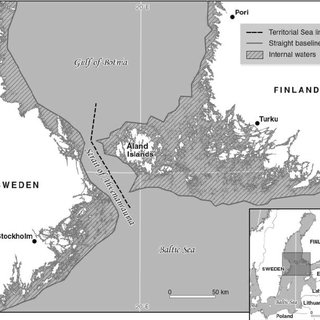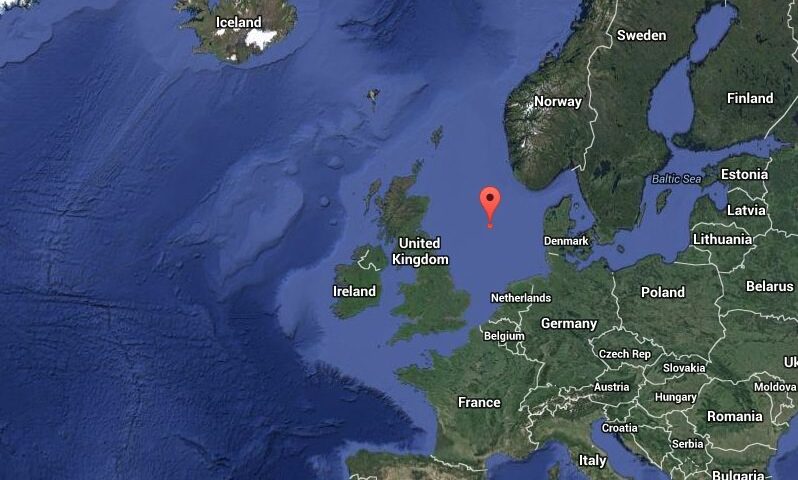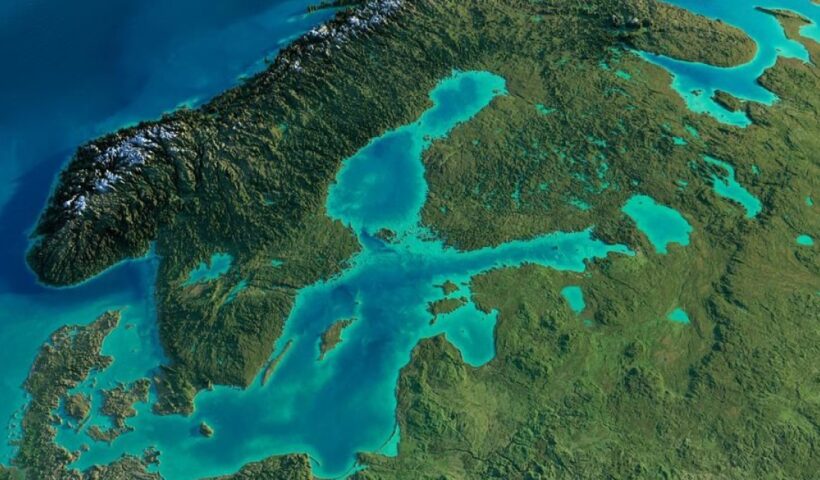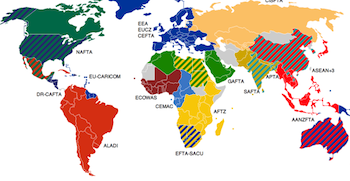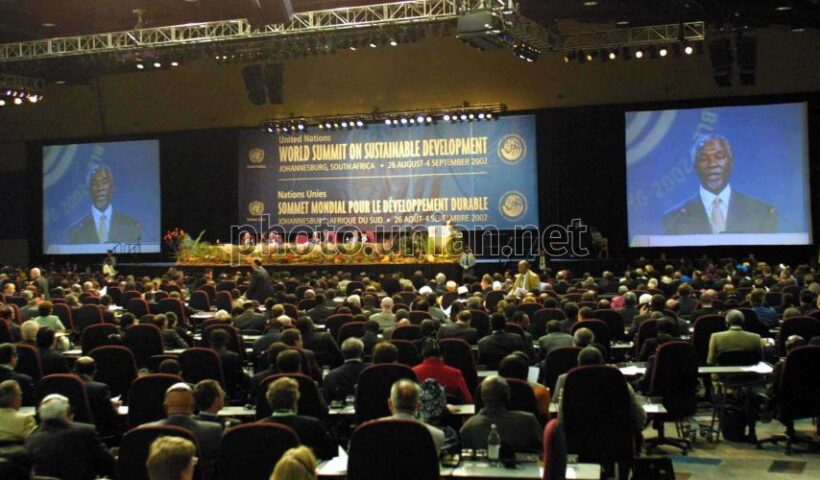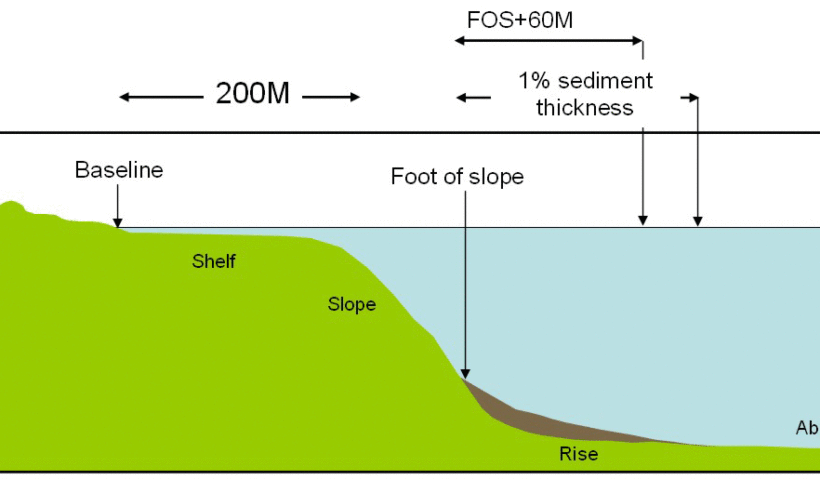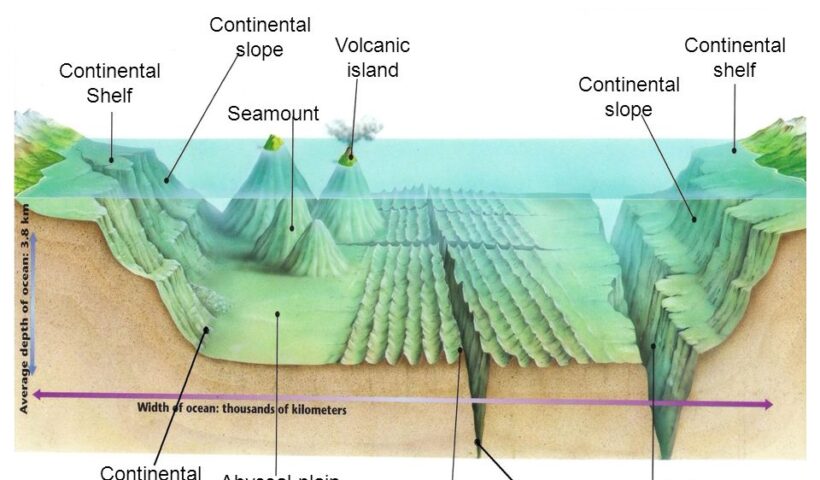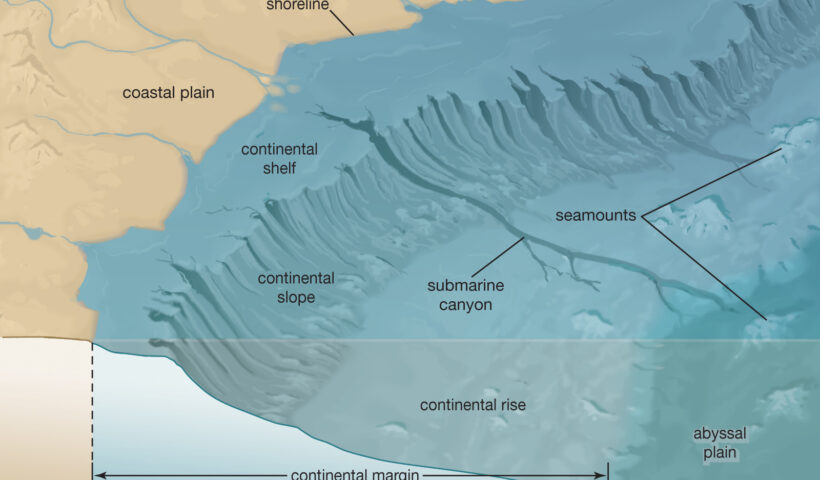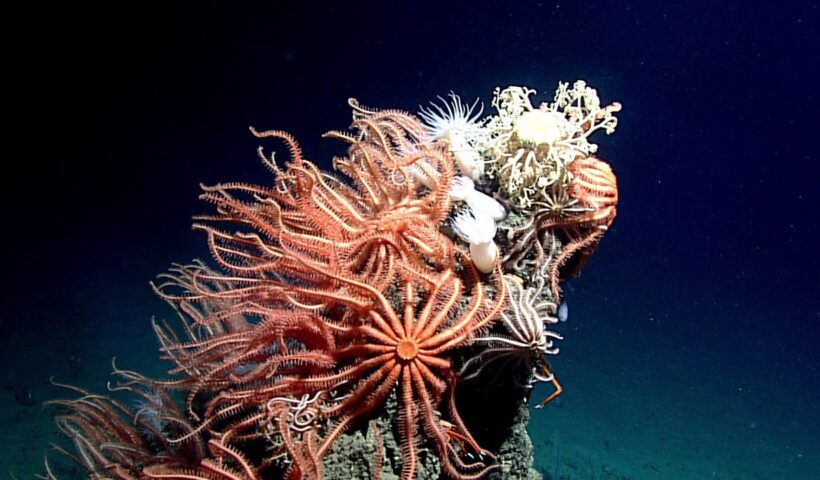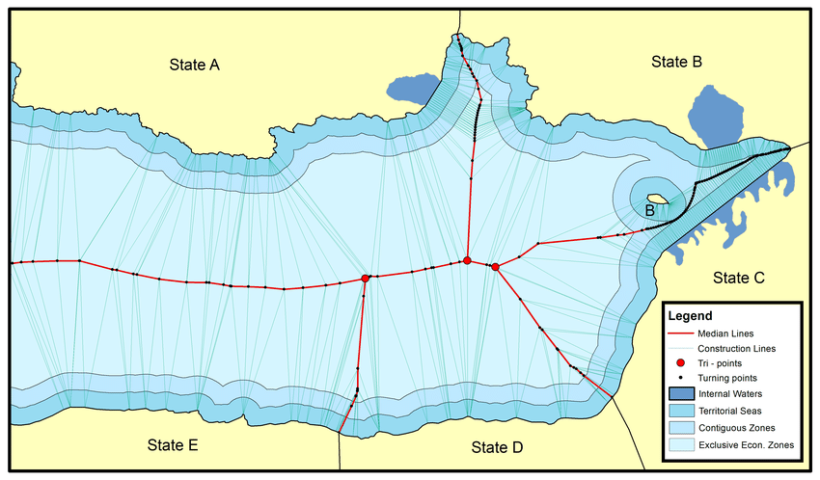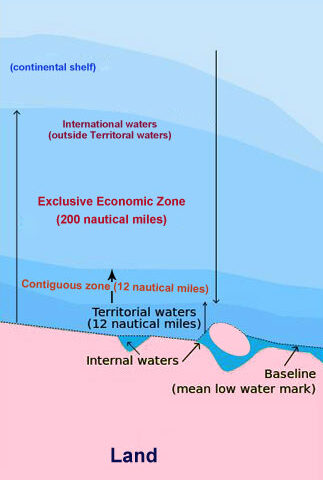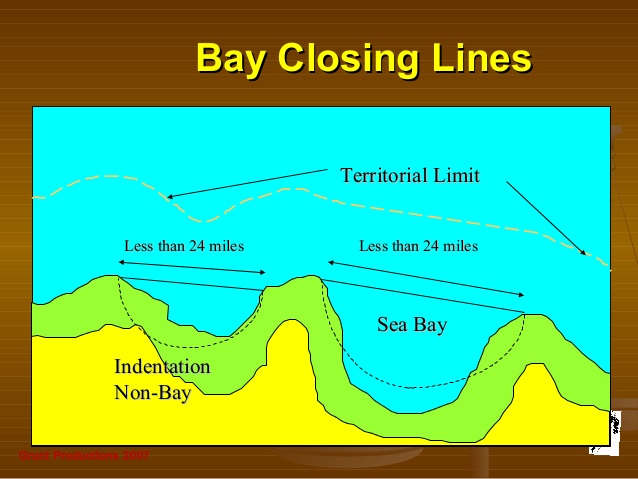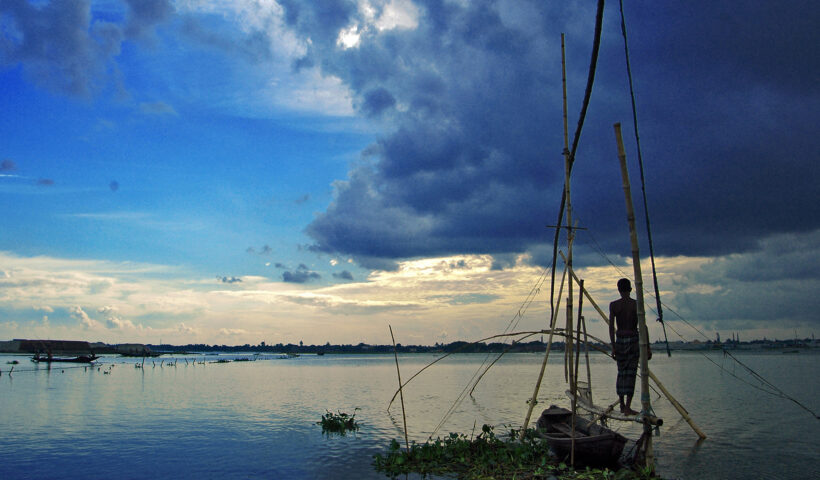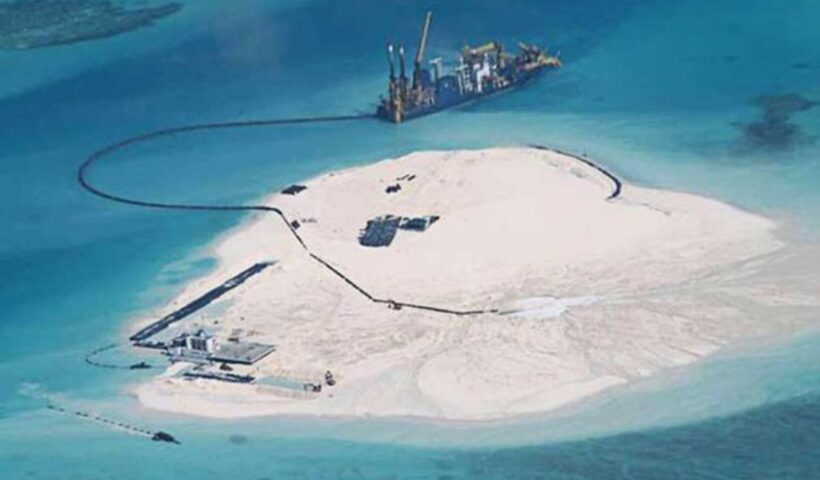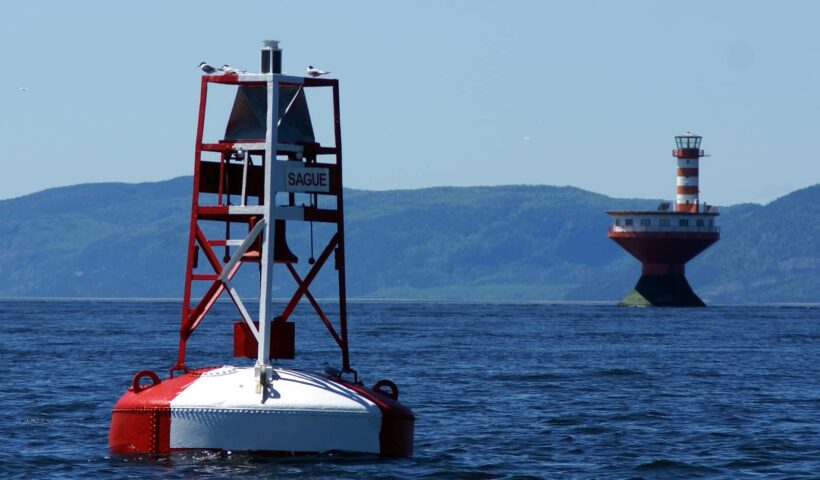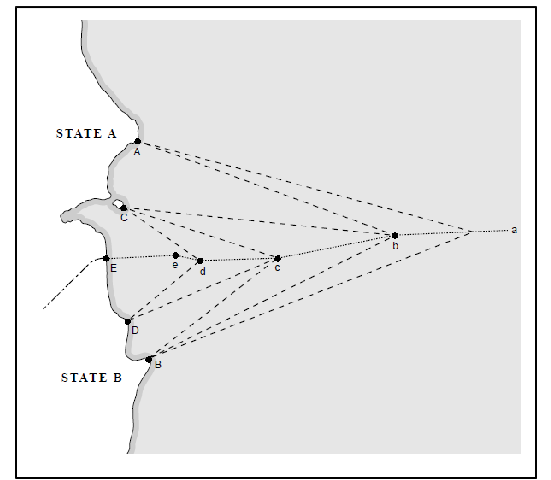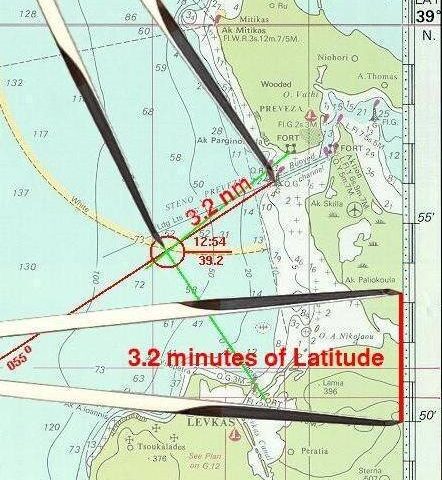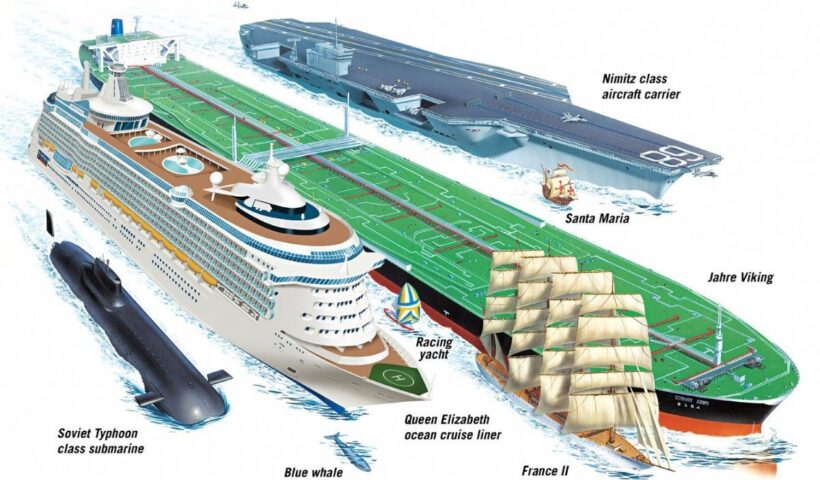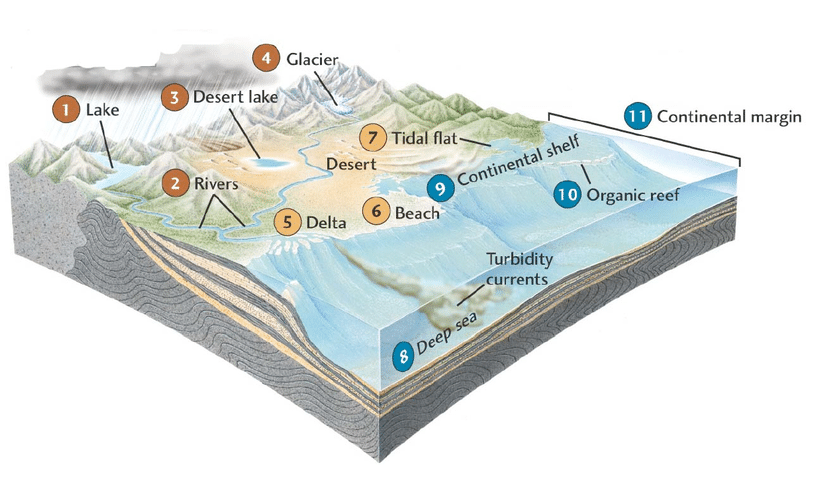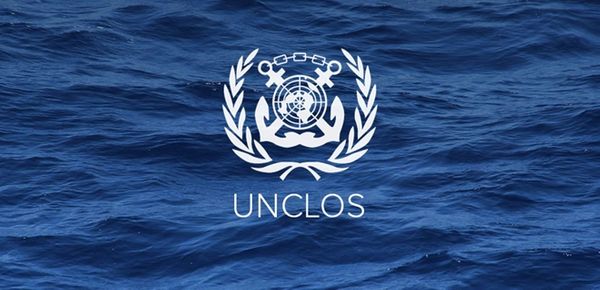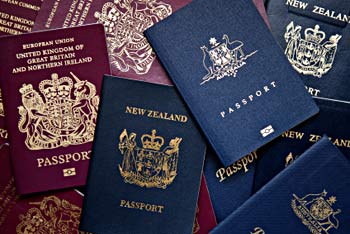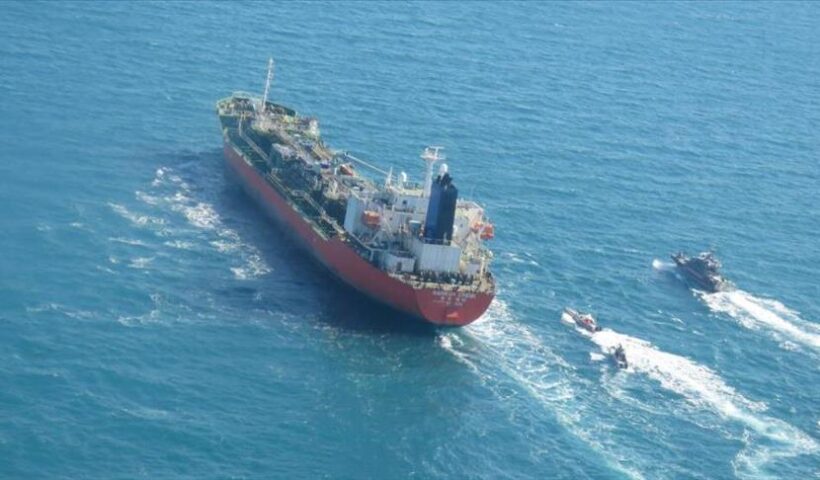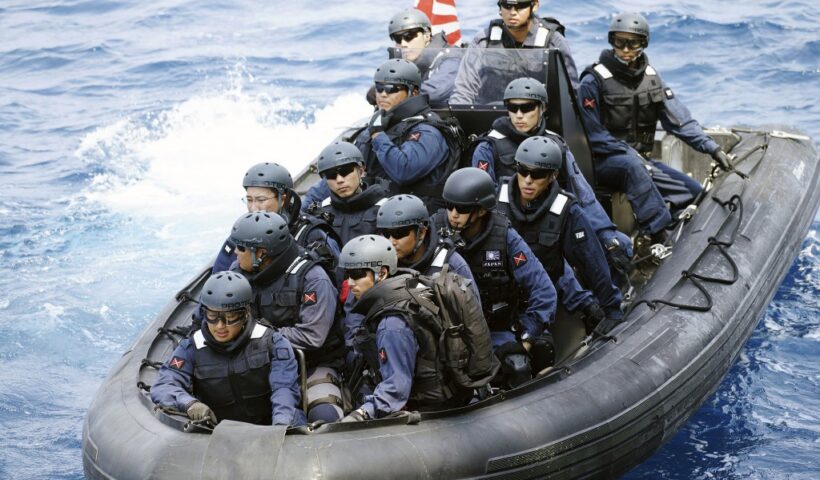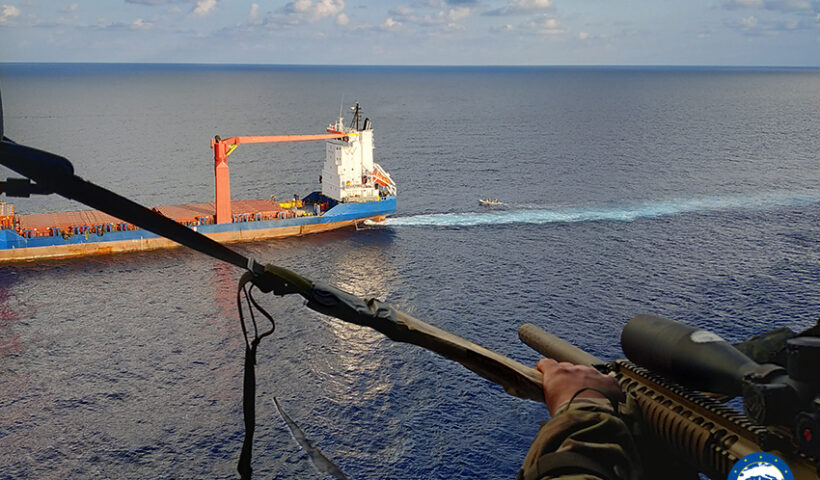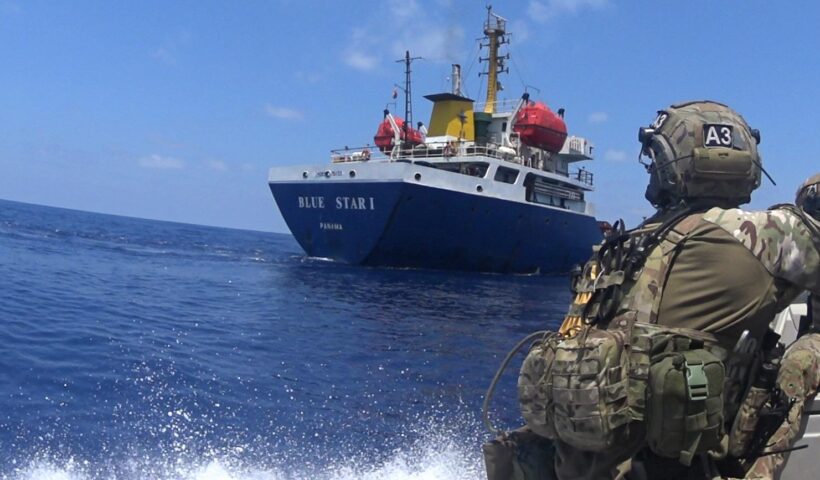This strategically important strait links the Red Sea and the Suez Canal with the Gulf of Aden and the Arabian Sea (see Map 29). It is about 14.5 miles wide at its narrowest part of the passage. When it signed the Law of the Sea Convention, the Yemen Arab Republic declared that warships and warplanes must obtain the prior agreement of the Yemen Arab Republic before passing through or over its “territorial waters,” including international straits. The United States Government protested as follows:
View More Navigational Regimes of Particular Straits, Bab El Mandeb case studyCategory: Law of the sea
The law of the sea is a body of customs, treaties, and international agreements by which governments maintain order, productivity, and peaceful relations on the sea. NOAA’s nautical charts provide the baseline that marks the inner limit of the territorial sea and the outer limit of internal waters.
Navigational Regimes of Particular Straits, Aland case study
When it ratified the LOS Convention in 1996, Finland confirmed its declaration on signature in part that:
It is the understanding of the Government of Finland that the exception from the transit passage regime in straits provided for in article 35(c) of the Convention is applicable to the strait between Finland (the Åland Islands) and Sweden. Since in that strait the passage is regulated in part by a longstanding international convention in force, the present legal regime in that strait will remain unchanged after the entry into force of the Convention. Navigational Regimes of Particular Straits, Aland case study, Aland case study, Finland, Gulf of Bothnia, international straits, legal regime in that strait, Particular Straits
The 1992 OSPAR Convention as a regional Implementation for Protection and Preservation of the Marine Environment
The OSPAR Convention establishes a comprehensive legal framework for the protection of the marine environment of the North-East Atlantic Area from all sources of marine degradation (not only pollution), except fishing, atmospheric and vessel-source pollution, which are considered to be appropriately regulated within other frameworks..The 1992 OSPAR Convention as a regional Implementation for Protection and Preservation of the Marine Environment, e North Sea and other parts of the North-East Atlantic, Oslo Dumping Convention, OSPAR, OSPAR Commission, OSPARCOM, Paris Convention on Land-based Pollution, Protection and Preservation of the Marine Environment, regional Implementation for Protection and Preservation of the Marine Environment, The 1992 OSPAR Convention
View More The 1992 OSPAR Convention as a regional Implementation for Protection and Preservation of the Marine EnvironmentThe 1992 Helsinki Convention as a regional Implementation for Protection and Preservation of the Marine Environment
The 1992 Helsinki Convention as a regional Implementation for Protection and Preservation of the Marine Environment, Baltic Sea, ecological restoration, Helsinki Convention, marine ecosystems, Protection and Preservation of the Marine Environment, regional Implementation for Protection and Preservation of the Marine Environment, The 1992 Helsinki Convention
View More The 1992 Helsinki Convention as a regional Implementation for Protection and Preservation of the Marine EnvironmentThe 1976 Barcelona Convention (BARCON) as a regional Implementation for Protection and Preservation of the Marine Environment
The 1976 Barcelona Convention (BARCON) as a regional Implementation for Protection and Preservation of the Marine Environment, 1976 Barcelona Convention for the Protection of the Mediterranean Sea against Pollution, Barcelona Convention, BARCON, Mediterranean sea, Preservation of the Marine Environment, Protection of the Mediterranean Sea against Pollution, UNCED, UNEP’s Regional Seas Agreements
View More The 1976 Barcelona Convention (BARCON) as a regional Implementation for Protection and Preservation of the Marine EnvironmentThe Regional Implementation Regime for Protection and Preservation of the Marine Environment
The Regional Implementation Regime for Protection and Preservation of the Marine Environment, Agenda 21, BARCON, Bern Convention for the Protection of European Habitats, Euro-Mediterranean Process, HELCOM, How can we protect the marine environment?, LOSC, OSPAR, Preservation of the Marine Environment, What are the obligations to protect and preserve the marine environment?, Who is the responsible about the protection of marine environment?
View More The Regional Implementation Regime for Protection and Preservation of the Marine Environment“Generally Accepted” and “Applicable” International Rules for Protection and Preservation of the Marine Environment
“Generally Accepted” and “Applicable” International Rules for Protection and Preservation of the Marine Environment, GAIRAS, How can we protect marine life from degradation?, How can we protect our marine environment?, International Maritime Organization, LOSC, Protection and Preservation of the Marine Environment, United Nations Environment Programme (UNEP), What are marine environmental issues?, What are the main divisions of the marine environment?, What are the obligations to protect and preserve the marine environment?, What are three important environmental laws?, What can you contribute in the preservation of marine life?, Who is the responsible about the protection of marine environment?, Why is it important to protect the marine environment?
View More “Generally Accepted” and “Applicable” International Rules for Protection and Preservation of the Marine EnvironmentWorld Summit on Sustainable Development (WSSD) and Protection and Preservation of the Marine Environment
World Summit on Sustainable Development (WSSD) and Protection and Preservation of the Marine Environment, Agenda 21, Protection and Preservation of the Marine Environment, What is the main aim of Agenda 21?, What is World Summit on Sustainable Development?, What was discussed at the Johannesburg Earth Summit?, What was the result of the 1992 Earth Summit?, WSSD
View More World Summit on Sustainable Development (WSSD) and Protection and Preservation of the Marine EnvironmentChapter 17 of Agenda 21 about the Protection and Preservation of the Marine Environment
Chapter 17 of Agenda 21 about the Protection and Preservation of the Marine Environment, Chapter 17 of Agenda 21, How many agreement are there in Agenda 21?, marine ecosystems, Preservation of the Marine Environment, What are the two principles of Agenda 21?, What is Agenda 21 and its principles?, What is the main aim of Agenda 21?
View More Chapter 17 of Agenda 21 about the Protection and Preservation of the Marine EnvironmentThe 1982 UN Law of the Sea Convention (LOSC) and the Protection and Preservation of the Marine Environment
The environmental regime established by the Convention is based on the combination of the jurisdictional rules of the law of the sea with objectives, principles and approaches of international environmental law. The protection and preservation of the marine environment is specifically regulated in Part XII which is the result of this combination.
However, due to the comprehensive character of the LOSC and the inter-sectoral nature of marine issues, relevant provisions can be found in different parts of the Convention (e.g., Parts V and VII on conservation and management of living resources in the EEZ and high seas or Part XIII on marine scientific research). The LOSC has codified the customary principles discussed in the previous section and, in some cases, has further clarified their content. The jurisdictional rules and Part XII are discussed separately in the next paragraphs. The 1982 UN Law of the Sea Convention (LOSC) and the Protection and Preservation of the Marine Environment, LOSC, Protection and Preservation of the Marine Environment, What do the provision of Unclos 1982 govern?, What does the law of the sea convention do?
(Pre-UNCED) Principles of Customary International Law about Protection and Preservation of the Marine Environment
The umbrella regime for the protection and preservation of the marine environment is composed, first of all, of principles of customary international law. These principles are legally binding and universally applicable regardless of their codification within a treaty. However, only a few of them apply to the marine environment and their contribution to ocean preservation is quite limited. (Pre-UNCED) Principles of Customary International Law about Protection and Preservation of the Marine Environment, How can we protect our marine environment?, Protection and Preservation of the Marine Environment, What are the 7 principles of environment?, What are the obligations to protect and preserve the marine environment?, What are the principles of environmental law?, What are the three most important principles of environmental management?
View More (Pre-UNCED) Principles of Customary International Law about Protection and Preservation of the Marine EnvironmentThe Law of the Sea and the Protection and Preservation of the Marine Environment
The Law of the Sea and the Protection and Preservation of the Marine Environment, How can we protect marine life from degradation?, How can we protect our marine environment?, marine environment, marine environment under the LOSC, Protection and Preservation of the Marine Environment, protection of the marine environment, UNCED, What are the obligations to protect and preserve the marine environment?, Why is it important to protect the marine environment?
View More The Law of the Sea and the Protection and Preservation of the Marine Environmentwhat is the meaning of “Fringing reef” in law of the sea, LOSC and customary international law
As used in UNCLOS Articles 6 and 47(7), “fringing reef ” means a reef attached directly to the shore or continental land mass, or located in their immediate vicinity.. what is the meaning of “Fringing reef” in law of the sea, LOSC and customary international law, Fringing reef, How a fringing reef is formed?, How long does it take for a fringing reef to form?, What is the brief description of fringing reefs?, what is the meaning of “Fringing reef” in law of the sea?, Why is fringing reef important?
View More what is the meaning of “Fringing reef” in law of the sea, LOSC and customary international lawwhat is the meaning of “Foot of the continental slope” in law of the sea, LOSC and customary international law
As used in UNCLOS Article 76, “foot of the continental slope” means the point where the continental slope meets the continental rise or, if there is no rise, the deep ocean floor. what is the meaning of “Foot of the continental slope” in law of the sea, LOSC and customary international law, continental margin, continental slope, foot of the continental slope, How far out is the continental slope?, what is the meaning of Foot of the continental slope?, Where is the continental slope?
View More what is the meaning of “Foot of the continental slope” in law of the sea, LOSC and customary international lawwhat is the meaning of “Equidistance line; equidistant line; median line” in law of the sea, LOSC and customary international law
In UNCLOS analysis, an “equidistance line,” synonymous with “equidistant line” or “median line,” means a line every point of which is equally distant from the nearest points on the baselines of two States. what is the meaning of “Equidistance line; equidistant line; median line” in law of the sea, LOSC and customary international law, equidistance line, equidistant line, How are maritime boundaries defined?, median line, What is a single maritime boundary?, What is median line principle?, What is unclos and its purpose?
View More what is the meaning of “Equidistance line; equidistant line; median line” in law of the sea, LOSC and customary international lawwhat is the meaning of “Continental slope” in law of the sea, LOSC and customary international law
“Continental slope” or “slope,” as used in UNCLOS Article 76, means that part of the continental margin lying between the continental shelf and the continental rise. The continental slope may not be uniform or abrupt and may locally take the form of terraces. The continental slope’s gradients are usually greater than 1.5 degrees.. what is the meaning of “Continental slope” in law of the sea, LOSC and customary international law, continental shelf, continental slope, How is a continental slope formed?, slope, What is continental slope?, What is the slope of the continental shelf?, Where is the continental slope?
View More what is the meaning of “Continental slope” in law of the sea, LOSC and customary international lawwhat is the meaning of “Continental rise” in law of the sea, LOSC and customary international law
As used in UNCLOS Articles 76(3) and 76(6), “rise,” i.e., the “continental rise,” is a submarine feature which is that part of the continental margin lying between the continental slope and the deep ocean floor. It usually has a gradient of 0.5 degrees or less and a generally smooth surface consisting of sediment.. what is the meaning of “Continental rise” in law of the sea, LOSC and customary international law, continental rise, continental slope, foot of the continental slope, UNCLOS, What is a continental rise in geology?, What is the depth of the continental rise?, What is the difference between continental slope and continental rise?, what is the meaning of “Continental rise” in law of the sea?
View More what is the meaning of “Continental rise” in law of the sea, LOSC and customary international lawwhat is the meaning of “Common heritage of mankind or common heritage of humankind” in law of the sea, LOSC and customary international law
what is the meaning of “Common heritage of mankind or common heritage of humankind” in law of the sea, LOSC and customary international law, common heritage of humankind, Common Heritage of Mankind, what is the meaning of “Common heritage of mankind?
View More what is the meaning of “Common heritage of mankind or common heritage of humankind” in law of the sea, LOSC and customary international lawwhat is the meaning of “Coastal State” in law of the sea, LOSC and customary international law
“Coastal State” is a State from whose coast or baselines the breadth of the territorial sea is measured, those baselines being determined in accordance with UNCLOS Articles 5–7, 9–10 and 47. what is the meaning of “Coastal State” in law of the sea, LOSC and customary international law, coastal State, coastal State obligations with respect to innocent passage, land-locked State, What is a coastal state under Unclos?, What is coastal state control?, What is the coastal state?, what is the meaning of “Coastal State” in law of the sea, Where is the coastal state?
View More what is the meaning of “Coastal State” in law of the sea, LOSC and customary international lawwhat is the meaning of “Coast” in law of the sea, LOSC and customary international law
what is the meaning of “Coast” in law of the sea, LOSC and customary international law, coastal State, low-water lines, margin of land, What are the principles of the Law of the Sea?, What is maritime law of the sea?, what is the meaning of “Coast” in law of the sea?, what is the meaning of “Coast”?
View More what is the meaning of “Coast” in law of the sea, LOSC and customary international lawwhat is the meaning of “Closing line” in law of the sea, LOSC and customary international law
“Closing line” is a dividing line between the internal waters and the territorial seas of a coastal State enclosing a river mouth, a bay or a harbor; or a dividing line for the archipelagic waters of an archipelagic State as stated in UNCLOS Articles 9–11 and 50.. what is the meaning of “Closing line” in law of the sea, LOSC and customary international law, what is the meaning of “Closing line” in law of the sea, LOSC and customary international law
View More what is the meaning of “Closing line” in law of the sea, LOSC and customary international lawwhat is the meaning of “Basepoint or point” in law of the sea, LOSC and customary international law
A “basepoint” when employed in UNCLOS analysis means any point on the baseline. In the method of straight baselines, where one straight baseline meets another at a common point, one line may be said to “turn” at that point to form another baseline. Such a point may be termed a “baseline turning point” or simply “basepoint.” In either case “point” means a location that can be fixed by geographic coordinates and geodetic datums meeting UNCLOS standards.. what is the meaning of “Basepoint or point” in law of the sea, LOSC and customary international law, baseline turning point, How are territorial waters defined?, How far do territorial waters extend?, How far off land is international waters?, Territorial Sea Convention, UNCLOS, What is baseline in law of sea?, What is low water line?, What is the difference between territorial waters and contiguous waters?, what is the meaning of “Basepoint or point” in law of the sea?
View More what is the meaning of “Basepoint or point” in law of the sea, LOSC and customary international lawwhat is the meaning of “Bank; bank(s)” in law of the sea, LOSC and customary international law
There are two definitions for “bank,” depending on its use in UNCLOS:
(a)The word “banks” in UNCLOS Article 9, when referring to river banks, means those portions of land that confine a river.
(b)The word “bank” in UNCLOS Article 76(6) means a submarine elevation located on the seabed of a continental margin over which the depth of water is relatively shallow; this includes the seabed of an island’s continental shelf as permitted by Article 121, over which the depth of water is relatively shallow.. what is the meaning of “Bank; bank(s)” in law of the sea, LOSC and customary international law, continental shelf, river, that portion of land that confines a river, what is the meaning of “Bank; bank(s)” in law of the sea?
what is the meaning of “Azimuth” in law of the sea, LOSC and customary international law
what is the meaning of “Azimuth” in law of the sea, LOSC and customary international law, How do you find azimuth?, Is azimuth the same as bearing?, What is azimuth true?, What is azimuth used for?, what is the meaning of “Azimuth” in law of the sea
View More what is the meaning of “Azimuth” in law of the sea, LOSC and customary international lawwhat is the meaning of “Atoll” in law of the sea, LOSC and customary international law
As used in UNCLOS Articles 6 and 47, “atoll” means a reef with or without an island situated on it surrounded by the open sea, that encloses or nearly encloses a lagoon.
what is the meaning of “Atoll” in law of the sea, LOSC and customary international law, Atoll, lagoon, What is an atoll in the ocean?, What is an example of an atoll?, What is the difference between an island and an atoll?, what is the meaning of “Atoll” in law of the sea?
View More what is the meaning of “Atoll” in law of the sea, LOSC and customary international lawwhat is the meaning of “Artificial island, offshore installation, installation (offshore)” in law of the sea, LOSC and customary international law
An “artificial island” or “offshore installation,” or “installation (offshore),” as used in UNCLOS means a human-made edifice in the territorial sea, in the EEZ, on the continental shelf, in archipelagic waters, or in ocean space governed by UNCLOS, which is usually employed to explore for or exploit marine resources. Artificial islands, offshore installations or installations (off-shore) may also be built for other purposes, such as marine scientific research, tide observations, resorts or residences, air terminals, transportation centers, traffic control, etc.. what is the meaning of “Artificial island, offshore installation, installation (offshore)” in law of the sea, LOSC and customary international law, artificial island, continental shelf, EEZ, How artificial islands are made?, How many artificial islands are there in the world?, offshore installation, Pipelines, Territorial Sea Convention, UNCLOS, What is the largest artificial island in the world?, Why did China build artificial islands?
View More what is the meaning of “Artificial island, offshore installation, installation (offshore)” in law of the sea, LOSC and customary international lawwhat is the meaning of “Aid(s) to Navigation; Navigational Aid(s)” in law of the sea, LOSC and customary international law
(a)“Aid to navigation” means the same as “navigational aid” or “facility (navigational)” as used in UNCLOS Articles 21(1)(b) and 43(a), and means a device, external to a vessel, charted or otherwise published, serving the interests of safe navigation. “Aid to navigation” may also include “warning signals” as used in Articles 60(3),147(2)(a) and 262 (b)Depending on the context, “navigational aid” may also mean a shipboard instrument or similar device used to assist in navigating a vessel.. what is the meaning of “Aid(s) to Navigation; Navigational Aid(s)” in law of the sea, LOSC and customary international law, Aid(s) to Navigation, facility (navigational), Navigational Aid(s)
View More what is the meaning of “Aid(s) to Navigation; Navigational Aid(s)” in law of the sea, LOSC and customary international lawwhat is the meaning of “Adjacent coasts” in law of the sea, LOSC and customary international law
As used in UNCLOS Articles 15, 74(1) and 83, “adjacent coasts” means coasts lying on either side of the land boundary between two adjoining States. States may have adjacent coasts under UNCLOS even if they do not share a common land boundary. what is the meaning of “Adjacent coasts” in law of the sea, LOSC and customary international law, adjacent coasts, jus cogens norms, UNCLOS, what is the meaning of “Adjacent coasts” in law of the sea
View More what is the meaning of “Adjacent coasts” in law of the sea, LOSC and customary international lawwhat is the meaning of “Accuracy” in law of the sea, LOSC and customary international law
In UNCLOS analysis, “accuracy” means the extent to which a measured or enumerated value, such as “mile” or “nautical mile,” agrees with an assumed or accepted value.
what is the meaning of “Accuracy” in law of the sea, LOSC and customary international law, “Accuracy” in law of the sea, 200 nautical miles, Why do ships use nautical miles instead of kilometres or statute miles?
difference between “Ship” or “Vessel” in law of the sea, LOSC and customary international law
“Ship” [and] “vessel” have the same, interchangeable meaning in the English language version of the 1982 LOS Convention. “Ship” is defined as a vessel of any type whatsoever operating in the marine environment, including hydrofoil boats, air-cushion vehicles, submersibles, floating craft and floating platforms. Where, e.g., “ship” or “vessel” is modified by other words, or prefixes or suffixes, as in the Article 29 definition of a warship, those particular definitions apply.
difference between “Ship” or “Vessel” in law of the sea, LOSC and customary international law, Difference between a ship and a vessel, LOS Convention, ship, UNCLOS, Vessel, warship, What defines a ship from a boat?, What does vessel mean?, What is the Difference Between a Boat?, What is vessel used for?
View More difference between “Ship” or “Vessel” in law of the sea, LOSC and customary international lawDefinitions Relating to the Continental Shelf on the LOSC and customary international law
Definitions Relating to the Continental Shelf on the LOSC and customary international law, adjacent coasts, basepoint or point, chart, continental rise, continental shelf, continental slope, deep ocean floor, foot of the continental slope, geodetic data, isobath, latitude, Limits of the Continental Shelf, line of delimitation, LOS Committee, oceanic ridge, sedimentary rock, submarine elevation, UNCLOS, What are the characteristics of the continental shelf?, What does continental slope mean?, What extended continental shelf?, What is continental shelf limit?, What is the importance of continental shelf?, What is the largest continental shelf?, Where is the continental shelf?
View More Definitions Relating to the Continental Shelf on the LOSC and customary international lawPrinciple of universality as a base of jurisdiction in law of the sea
The qualification present in this passage gave rise to the pure ‘mandatory’ form of universal jurisdiction, according to which each State assumes jurisdiction and consequently must prosecute all offences generally recognised as of universal concern, regardless of where the offence took place or who the perpetrator or the victims were.
However, this ‘unilateral limited universality principle’ is distinguished from the ‘co-operative limited universality principle’, which confers upon the State the right rather than the obligation (may instead of must) to prosecute; in such a situation Grotius was quite categorical:
“Alterum facere debeat, aut ut ipsa interpellata pro merito puniat nocentem, aut ut eum permittat arbitratio interpellantis.” Principle of universality as a base of jurisdiction in law of the sea, Principle of universality as a base of jurisdiction in law of the sea
Principle of nationality as a base of jurisdiction in law of the sea
The connection between the State and its nationals is one of the oldest legal links. For long centuries jurisdiction applied to the person, wherever that was to be found, rather than to a defined territory – indeed, traces of this personal jurisdiction may still be found in the case, common in civil law countries, where a national commits a criminal act abroad (active personality principle). The contemporary manifestation of this possibility, long considered unthinkable in common law jurisdictions, allows for the prosecution of international crimes by the State of nationality of the perpetrator in lieu of surrendering such individual to the International Criminal Court and of major criminal offences, including sex crimes committed abroad; and even serves as the foundation for the criminalisation of active corruption urbi et orbi. Principle of nationality as a base of jurisdiction in law of the sea, 1966 International Covenant on Civil and Political Rights, 1989 Convention on the Rights of the Child, 1997 European Convention on Nationality, Law of the Sea Convention, LOS Convention, Principle of nationality
View More Principle of nationality as a base of jurisdiction in law of the seaPrinciple of territoriality as a base of jurisdiction in law of the sea
Principle of territoriality as a base of jurisdiction in law of the sea, D’Amato-Kennedy Act, jurisdiction in law of the sea, LOSC, objective territorial jurisdiction, Permanent Court of International Justice, Principle of territoriality, UN Charter
View More Principle of territoriality as a base of jurisdiction in law of the seaThe Right to Visit of a foreign-flagged vessel in law of the sea and customary international law
The Right to Visit of a foreign-flagged vessel in law of the sea and customary international law, The Right to Visit of a foreign-flagged vessel in law of the sea and customary international law
View More The Right to Visit of a foreign-flagged vessel in law of the sea and customary international lawSelf-Defence and Maritime Interception in law of the sea, maritime law and customary international law
Self-Defence and Maritime Interception in law of the sea, maritime law and customary international law, law of the sea, maritime law, self-defence, Self-Defence and Maritime Interception, The Right of Self-Defence, UN Charter, UN Security Council
View More Self-Defence and Maritime Interception in law of the sea, maritime law and customary international lawwhat is the meaning of Explicit Maritime Embargo Operations?
what is the meaning of Explicit Maritime Embargo Operations?, Explicit Maritime Embargo Operations, Maritime Embargo Operations, NATO, UNSC, WEU operations
View More what is the meaning of Explicit Maritime Embargo Operations?Legal Basis for Implied Maritime Embargo Operations
Legal Basis for Implied Maritime Embargo Operations, economic sanctions at sea, Legal Basis for Implied Maritime Embargo Operations, UNSC
View More Legal Basis for Implied Maritime Embargo Operationswhat is the meaning of Maritime Embargo Operations in LOSC and customary international law?
what is the meaning of Maritime Embargo Operations in LOSC and customary international law?, economic enforcement measures, flag states, Iraq, lebanon, Libya, LOSC, Maritime Embargo Operations, NATO, Sierra Leone, Southern Rhodesia, The Former Yugoslavia, UN Charter, UNSC, Western European Union (WEU)
View More what is the meaning of Maritime Embargo Operations in LOSC and customary international law?The UN Collective Security System and Maritime Interception Operations
The UN Collective Security System and Maritime Interception Operations, Maritime Interception Operations, MIO, NATO, UN Collective Security System, UN peacekeeping operations, UN Security Council, UN-mandated, UNBEF, UNMIF, UNSC
View More The UN Collective Security System and Maritime Interception Operations

